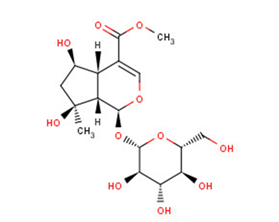
Shanzhiside methyl ester
CAS No. 64421-28-9
Shanzhiside methyl ester( —— )
Catalog No. M18948 CAS No. 64421-28-9
Shanzhiside methylester reduces neuropathic pain by activating spinal GLP-1 receptors and subsequently stimulating microglial β-endorphin expression via the p38 MAPK signaling.
Purity : >98% (HPLC)
 COA
COA
 Datasheet
Datasheet
 HNMR
HNMR
 HPLC
HPLC
 MSDS
MSDS
 Handing Instructions
Handing Instructions
| Size | Price / USD | Stock | Quantity |
| 5MG | 58 | In Stock |


|
| 10MG | 103 | In Stock |


|
| 25MG | 190 | In Stock |


|
| 50MG | 283 | In Stock |


|
| 100MG | Get Quote | In Stock |


|
| 200MG | Get Quote | In Stock |


|
| 500MG | Get Quote | In Stock |


|
| 1G | Get Quote | In Stock |


|
Biological Information
-
Product NameShanzhiside methyl ester
-
NoteResearch use only, not for human use.
-
Brief DescriptionShanzhiside methylester reduces neuropathic pain by activating spinal GLP-1 receptors and subsequently stimulating microglial β-endorphin expression via the p38 MAPK signaling.
-
DescriptionShanzhiside methylester reduces neuropathic pain by activating spinal GLP-1 receptors and subsequently stimulating microglial β-endorphin expression via the p38 MAPK signaling.
-
In Vitro——
-
In VivoShanzhiside methyl ester exerts dose-dependent and long-lasting (>4 h) anti-allodynic effects in spinal nerve injury-induced neuropathic rats, with a maximal inhibition of 49% and a projected ED50 of 40.4 μg.
-
Synonyms——
-
PathwayCell Cycle/DNA Damage
-
TargetDNA/RNA Synthesis
-
RecptorGLP-1
-
Research Area——
-
Indication——
Chemical Information
-
CAS Number64421-28-9
-
Formula Weight406.38
-
Molecular FormulaC17H26O11
-
Purity>98% (HPLC)
-
SolubilityIn Vitro:?DMSO : 100 mg/mL (246.08 mM)
-
SMILES[C@@H]1([C@H]2[C@@H](C(=CO1)C(=O)OC)[C@@H](C[C@]2(C)O)O)O[C@@H]1O[C@@H]([C@H]([C@@H]([C@H]1O)O)O)CO
-
Chemical Name——
Shipping & Storage Information
-
Storage(-20℃)
-
ShippingWith Ice Pack
-
Stability≥ 2 years
Reference
1. Fan PC,et al. Biomed Chromatogr. 2012 Dec;26(12):1543-51.
molnova catalog



related products
-
Saframycin A
A heterocyclic quinone antibiotic that inhibits RNA synthesis in vivo and in vitro.
-
NCGC00029283
NCGC00029283 is a potent inhibitor of Werner syndrome helicase-nuclease (WRN), displaying inhibitory activity against WRN helicase with an IC 50 value of 2.3 μM.
-
SMN-C2
SMN-C2 is a selective regulator of SMN2 gene splicing, a risdiplam analogue, a selective RNA-binding ligand that regulates pre-mRNA splicing and acts by binding to SMN2 pre-mRNA.



 Cart
Cart
 sales@molnova.com
sales@molnova.com


